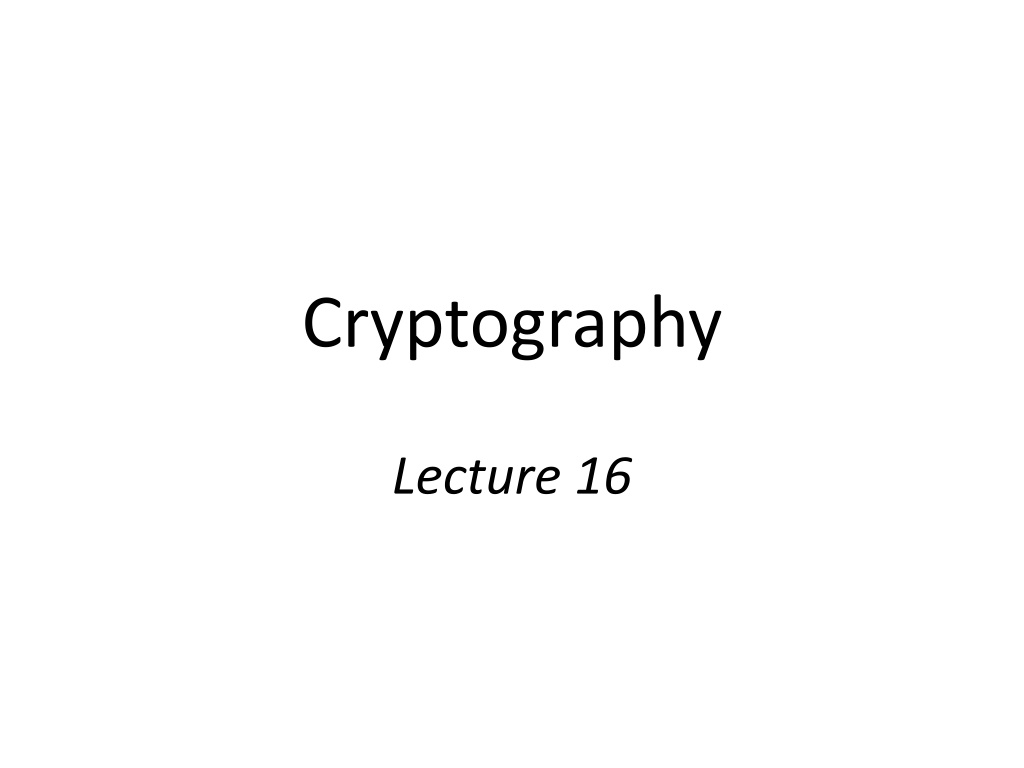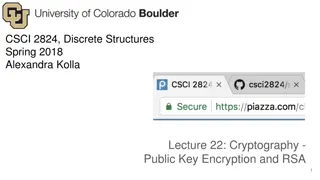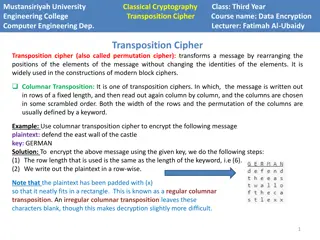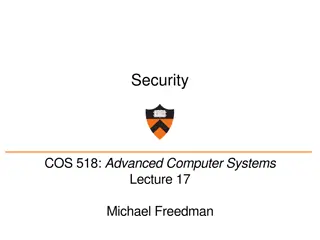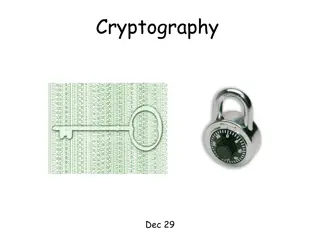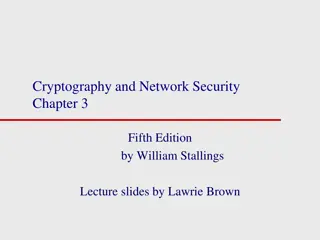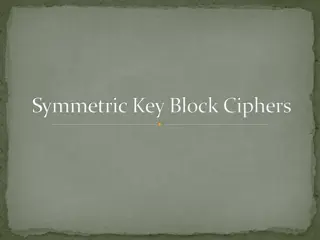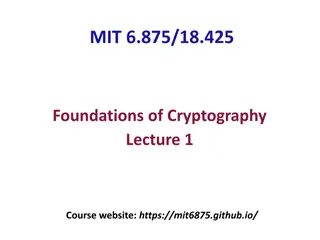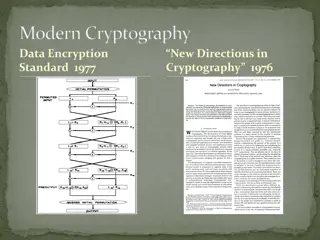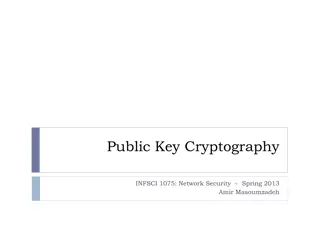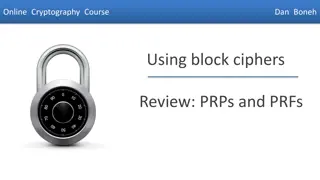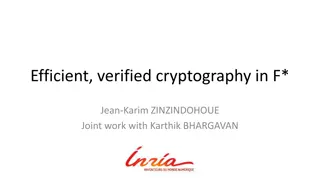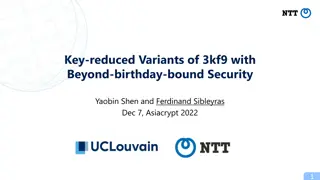Understanding Block Ciphers in Cryptography
Explore the world of block ciphers in cryptography through topics such as distinguishing attacks, key-recovery attacks, designing paradigms like Substitution-Permutation Networks (SPNs) and Feistel networks, concrete security considerations, confusion/diffusion principles, attack models, and more.
Download Presentation

Please find below an Image/Link to download the presentation.
The content on the website is provided AS IS for your information and personal use only. It may not be sold, licensed, or shared on other websites without obtaining consent from the author. Download presentation by click this link. If you encounter any issues during the download, it is possible that the publisher has removed the file from their server.
E N D
Presentation Transcript
Cryptography Lecture 16
Recall Want keyed permutation F: {0,1}nx {0,1}l {0,1}l n = key length, l= block length Want Fk(for uniform, unknown key k) to be indistinguishable from a uniform permutation over {0,1}l
Attack models A block cipher is not an encryption scheme!! Nevertheless, some of the terminology used is the same (for historical reasons) known-plaintext attack : attacker given {(x, Fk(x)} for arbitrary x (outside control of the attacker) chosen-plaintext attack : attacker can query Fk(.) chosen-ciphertext attack : attacker can query both Fk(.) and Fk-1(.)
Concrete security We are interested in concrete security for a given key length n Best attack should take time 2n If there is an attack taking time 2n/2then the cipher is considered insecure Look at distinguishing attacks and key- recovery attacks
Designing block ciphers Want Fk(for uniform, unknown key k) to be indistinguishable from a uniform permutation over {0,1}l If x and x differ in one bit, what should be the relation between Fk(x) and Fk(x )? How many bits should change (on average)? Which bits should change? How to achieve this?
Confusion/diffusion Confusion Small change in input should result in local, random change in output Diffusion Local change in output should be propagated to entire output
Design paradigms Two design paradigms Substitution-permutation networks (SPNs) Feistel networks
SPNs Build random-looking perm. on long input from random perms. on short input What is the key length for a random permutation on {0,1}l ? E.g. (assuming 8-byte block length), Fk(x) = fk1(x1) fk2(x2) fk8(x8), where each f is a random perm. on {0,1}8 How long is the key for F?
SPN . . . fk1 fk2 fk8 Is this a pseudorandom permutation?
SPN This has confusion but no diffusion Add a mixing permutation
SPN . . . fk8 fk1 fk2 . . .
SPN Mixing permutation is public Chosen to ensure good diffusion (This will be more clear later) Note that the structure is invertible (given the key) since the f s are permutations and the mixing permutation is invertible
SPN . . . fk8 fk1 fk2 . . . Does this give a pseudorandom permutation?
SPN . . . fk8 fk1 fk2 . . . What if we repeat for another round? (With independent, random functions?)
SPN What is the minimal # of rounds we need? Avalanche effect Judicious choice of mixing permutation
SPNs Using random f s is not practical Key would be too large Instead, use f s of a particular form fki(x) = Si(ki x), where Si is a fixed (public) permutation The {Si} are called S-boxes (substitution boxes) XORing the key is called key mixing Note that this is still invertible (given the key)
Avalanche effect Design S-boxes and mixing permutation to ensure avalanche effect Small differences should eventually propagate to entire output S-boxes: any 1-bit change in input causes 2-bit change in output Not so easy to ensure! Mixing permutation Each bit output from a given S-box should feed into a different S-box in the next round
SPN One round of an SPN involves Key mixing Ideally, round keys are independent In practice, derived from a master key via a key schedule Substitution (S-boxes) Permutation (mixing permutation) r-round SPN has r rounds as above, plus a final key-mixing step Why? Invertible regardless of how many rounds
Key-recovery attacks Key-recovery attacks are even more damaging than distinguishing attacks As before, a cipher is secure only if the best key- recovery attack takes time 2n A fast key-recovery attack represents a complete break of the cipher
Key-recovery attack, 1-round SPN Consider first the case where there is no final key-mixing step Possible to get the key immediately!
Key-recovery attack, 1-round SPN Consider first the case where there is no final key- mixing step Possible to get the key immediately! What about a full 1-round SPN (with independent round keys)? Attack 1: for each possible 1st-round key, get corresponding 2nd-round key Continue process of elimination using additional plaintext/ciphertext pairs Complexity 2l for key of length 2l
Key-recovery attack, 1-round SPN Better attack: work S-box-by-S-box Assume 8-bit S-box For each 8 bits of 1st-round key, get corresponding 8 bits of 2nd-round key Continue process of elimination Complexity?
